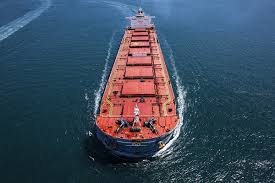
After containers, dry bulk shipping is red hot now
The Baltic Dry Index or BDI, London-based Baltic Alternate’s foremost sea freight index that tracks charges to ship dry bulk commodities, rose essentially the most in over ten years on Wednesday lifting the spirits of dry bulk ship homeowners who’ve been envious of the spectacular experience of container ship homeowners over the past couple of months.
On Wednesday, the BDI which tracks charges for capesize, panamax and supramax vessels rose 109 factors or 3.5 per cent to three,266 factors, its highest since June 2010.
The capesize index rose 224 factors or 4.Three per cent, to five,404 factors.
Common each day earnings for capesizes, which usually transport 1,50,000-tonne cargoes of coal and iron ore, had been up $1,858 at $44,817.
The panamax index rose 124 factors or 4.6 per cent, to an over one-month excessive of two,848 factors.
Common each day earnings for panamaxes, which usually carry coal or grain cargo of about 60,000 tonnes to 70,00 tonnes, elevated by $1,119 to $25,634.
However, container transport charges have been sky-rocketing on the again of kit shortages and area crunch borne out of pandemic-induced disruptions.
On Wednesday, Maersk Line, the world’s largest container transport firm, posted the perfect quarter in its historical past, reporting a web revenue of $2.7 billion for the primary three months of the 12 months, in contrast with $209 million for the primary quarter final 12 months.
The Danish transport and logistics group stated that “extraordinary market situations” contributed to “round $2 billion” of the web revenue.
Provide and demand
Transport trade executives stated that the present rally within the dry bulk phase is supported each from provide and demand facet.
On the availability facet, the decrease year-on-year fleet progress and port congestion have aided the rally.
Between January and April, the web dry bulk fleet grew by 1.2 per cent (10.eight million useless weight tonnage or dwt) in comparison with 1.6 per cent throughout the identical time final 12 months (14.5 million dwt).
The worldwide dry bulk order guide stands at 5.6 per cent of the fleet, the bottom no less than since 1996 and the fleet progress is anticipated to decelerate additional within the second half of 2021 and 2022.
Between January and April, new contracts for establishing dry bulk ships have been decrease – solely 5.1 million DWT has been ordered, down 37 per cent year-on-year.
The primary quarter of calendar 12 months 2021 witnessed the best port congestion because the first quarter of 2012. This lowered energetic fleet provide within the system.
“Even now, congestion stays elevated at load ports of Brazil and Australia,” an government with a Mumbai-based transport firm stated.
The demand facet has been propped up by sturdy year-on-year progress in commerce throughout all dry bulk commodities akin to iron ore, grains, metal, cement and fertilisers.
From April, coal has additionally began “positively including” to the commerce progress.
Within the first quarter of the calendar 12 months, the world metal output grew by greater than 10 per cent YoY with Chinese language metal output rising by over 16 per cent.
Chinese language metal costs are the best within the final 10 years led by sturdy home demand. The sturdy metal margins are incentivizing use of high-grade Brazilian iron ore, an enormous constructive for dry bulk transport on lengthy haul routes.
Iron ore worth of $194 a ton (10-year excessive) is incentivicing even minor producers like India to export extra iron ore volumes, boosting demand for supramax vessels.
China is scooping up provides of US corn and wheat to feed its livestock. Demand for feedstock has elevated publish the Asian swine flu that led to the culling of giant hog inhabitants in China.
Within the first quarter, thermal energy era in China grew by 21 per cent YoY and with the prevailing low inventory ranges in China and India, coal imports are anticipated to drive demand for dry bulk ships.
Source ; The Hindu Business line
